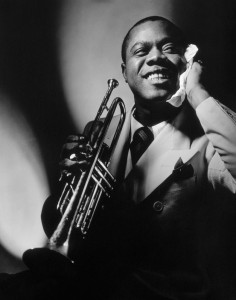Louis Armstrong’s Black & Blues, a new documentary about the 20th century’s preeminent jazz artist, succeeds at being a breezy, visually engaging take on its vast subject. The film opens in Armstrong’s hometown on Friday, October 28, at the Prytania Theatres at Canal Place. It starts streaming the same day at Apple TV+.
Fifty-one years after his death, Black & Blues is a major reentry for Louis Armstrong into the contemporary mainstream. Sacha Jenkins, whose previous projects include 2019s Wu Tang Clan: Of Mics and Men and last year’s Bitchin: The Sound and Fury of Rick James, directed the film for executive producers Ron Howard and Brian Grazer.
Jenkins guides Black & Blues with a nimble mix of verve and sincerity. He respects Armstrong without fawning over him, eschewing the cloying tone music documentaries so often apply to their respective subjects. Armstrong’s artistry and impact are so singular that there’s no need to exaggerate.
Before Jenkins directed Black & Blues, he probably knew only a little more about Armstrong than most early 21st century Americans do. Jenkins educated himself about New Orleans’ favorite son, a process of discovery that potentially can expose new generations to Armstrong’s charismatic genius.
Black & Blues thankfully avoids some documentary clichés. There are no talking-head experts, peers or celebrities. There’s no voice-of-God narration. Armstrong tells most of the story himself, on and off camera. Because he made so many film and television appearances, he’s a documentary filmmaker’s dream. He also privately made a treasure trove of audio recordings at his home in Corona, Queens, New York. These reel-to-reel tapes feature his personal musings as well as conversations with friends, musicians and his fourth wife, Lucille Wilson.
When Jenkins wants Armstrong’s writings heard, rapper Nas reads them. A number of voiceover recollections and observations from musicians are here, too, including New Orleans’ Danny Barker and Wynton Marsalis. Armstrong scholar and Satchmo SummerFest regular Ricky Riccardi is another of the film’s off-camera voices, and New Orleans’ Terence Blanchard composed the non-Armstrong musical portions of the soundtrack.
Running one hour and 44 minutes, Black & Blues covers Armstrong’s childhood in New Orleans, his music instruction at the Colored Waifs Home for Boys and his migration to Chicago and then New York, the city where he achieved the stardom he sustained for the rest of his life. Pianist Lil Hardin, the first of Armstrong’s four wives, says in a vintage interview that she insisted he leave Oliver’s band and become the front man he was destined to be.
Jenkins includes almost nothing about Armstrong’s musical brilliance. That’s an oversight, because elucidations for it do exist on film, especially in Satchmo: The Life of Louis Armstrong, the 1989 documentary written and co-directed by the award-winning jazz critic and Armstrong biographer Gary Giddins.
Black & Blues does include some of Armstrong’s rare public statements about race in America as well as some of his largely unheard private thoughts about the topic. The United States was extensively segregated during most of his life and not even he, a nationally known star, was immune to the injustices Black Americans faced. In this segment of Black & Blues, the filmmakers present a nuanced portrait of a famous and transformative artist who for decades was perceived by younger African Americans as a hat-tipping Uncle Tom.
“They didn’t understand Louis,” the late writer Amiri Baraka says, “because Louis was always affable, always smiling.”
Baraka’s defense of the artist who was both loved and distained dovetails into Armstrong’s own take on his extraordinary life. “Well, folks,” he says, “that was my life, and I enjoyed all of it.”
Friday, October 28, at the Prytania Theaters Canal Place, 290-2658.
New Orleans Film Festival, Friday, November 4 at the Prytania Theater Uptown, 891-2787.




